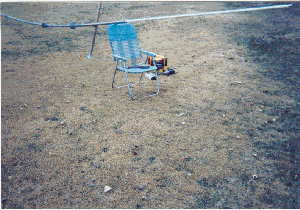
*2 Meter Base Combination Antenna*
Cleaning up the Antenna Farm
Starting out in the HAM radio craft is challenging, mostly rewarding but can be aggrievating and disappointing when trying to make the little 2 Meter work outside its parameters. A new Technician Class Operator usually starts out with a simple mobile and/or HT for their main form of communication and quickly discovers they can not "reach out" as far as expected or desired. Depending on your A.O. your 2 Meter radio can be fairly good for around 40 miles simplex in the flatlands using around 50 watts and a decent antenna but in the hills of Alabama at the last IC I was surprised at how poor the performance was on our lower powered HTs. Large hills and deep valleys really kept the little 2 Meter HTs from working very well..
In the flatlands of the central states our performance is fairly respectable with the use of elevated masts and 60+ watts. Directional "Yagi" Antennas greatly enhance the performance of the 2 Meter radio and can be fairly secure for short range "straight line comms". Being non-omni directional, rather straight line an operator can make short calls station to station and be fairly secure in the knowledge that he/she can't be monitored unless someone has a radio on the 2 stations frequency and are in the line of transmission. Add CW (Continuous Wave or Morse Code) and security increases tremendously.....
Omni Directional Antennas are good basic antennas for local operation. They are equal in RF radiation direction so an operator may be talking to a station on simplex 20 miles to the north and another station 20 miles to the south will be able to monitor them with ease..My challenge was I wanted to use an Omni Directional Antenna and a 3 element Yagi Directional Antenna at the highest elevation possible (Taking our notorious high winds into consideration). At one time I had 2 Omni-Directional 2 Meter antennas and a taller Yagi directional antenna, our house started looking like a CIA compound considering I had also rigged 2 HF G5RV antennas and a random wire antenna for longer range HF operations.
I needed to consolidate the two different 2 Meter Antennas together and I wanted them to "blend" into the small rural farm community we live in. I studied comman set ups in our locale and decided that I could mount a Tech America 8.2' 2m/70cm Dual Band Antenna with a 6.0dB gain on a 40 foot pole and have a Yagi three element Directional Antenna under it and it would somewhat resemble the antenna setup that the cable company uses because it is too cost prohibitive to run a cable wire out here for a few customers. This is what I developed and how I did it. I often attempt to do chores like this by myself, it can be very flustrating but I am trying to teach myself how to do it solo so if I have to I know I can...When out camping/training I have a 30 foot camoflaged collaspable pole with a Yagi Directional Antenna I erect myself to establish area comms on 2 Meter.

Whenever I start on a new project I try to put some forthought into it, this involves preassembling parts and gathering tools that are anticipated for the job. It is alot better to discover a section or part that doesn't fit well or will not work at all while it is in the preassembly stage on the ground where you can easily remedy the situation. I have in the past had an antenna assembled and in the air only to discover a section collar did not fit so I had to tear the entire rig down and start over. Sometimes sketching the project can be helpful also.
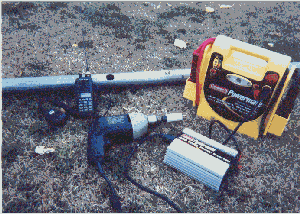
It is also wise to predrill and precut everything on the mast you can think of while the parts are still on the ground. Here a 1" diameter hole saw is incorparted to cut a hole for the RG58 cable and fittings to slide through. Using this method is a favorite of mine as the cable is protected from damage and from the elements and it also looks alittle more professional. This is my " Arkansas Cordless Drill" setup. With some patience and articulation one can make a slotted hole in the mast with the round hole saw as seen just right of the HT.
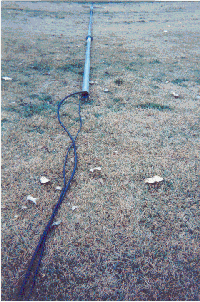
Once you have worked the cable through the pole and fit the antennas you are almost ready to erect the antenna. One note on feeding the cable through the pole. Collapse the antenna pole to its smallest height, that way you are feeding 15-20 feet of cable instead of the entire 40 feet, this will save you a TON of unneeded effort and trouble. Then when the cable is through the pole, expand the pole carefully making sure not to snag the cable as it feeds into the expanding pole. This can be very tedious so take you time, it will be well worth your effort!
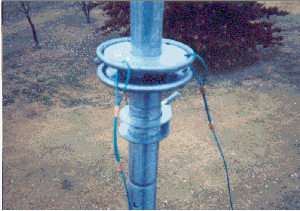
The big advantage of using the collapsable mast is when collasped you can easily erect it by yourself, mount it to your house or nearby structure then expand it slowly and carefully while it is relativaly safely anchored down. Once expanded you can rig the guide wires. Guide wires (Sometimes refered to as "Guy Wires") are a very important part of antennas over 20' so do not scrimp or omit. Be sure to use only the highest quality of cable and ferrals and always use wire tensioners to final adjust the guide wires properly.
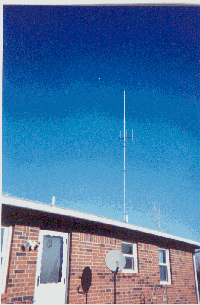
This is the finished product. Kinda blends in don't it? You can now have a good omni-directional 2 Meter Antenna for normal close range unsecured comms and a Yagi Directional 2 Meter Antenna for more secure and long distance comms. As of the time of this article I have not yet aquired an antenna switch which I highly recommend. Until I get one I will still have to go outside under the pole and unscrew one antenna lead and connect the other manualy. This is particularly delightful in the pouring rain! The mast must be tuned by hand twisting to adjust direction for the Yagi Antenna, pointing is an artful skill and an entirely different subject to write about. I use a GPS Grid map and a Military compass to determine the exact direction then when outside under the antenna I can point it with suprising accuracy. The greater the distance the more critical the direction pointing is. I have established good reliable comms to a repeater 70 miles from my A.O. There is one station 30 miles farther which makes the total distance 100 miles! For much more secure comms Simplex (Non-repeater) mode is used at 70 miles and under which is still very good for the little 2 Meter. Note: I already had the proper 8' copper rod to ground the antenna mast to in place from my previous set up. Most ground rods can be purchased for under 20$ and you want to have one for many very good reasons, safety from lightening and avoiding frying your expensive equipment are the main ones.
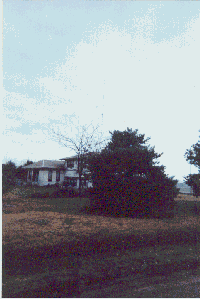
This is a photo of a house nearby with a cable television antenna setup, this could almost pass for a 2 Meter rig, and vice versa! There are many problems and challenges we face when we decide we want to get licensed and start throwing RF waves into the air. I needed good height for better transmitting and recieving, options on choice of Omni-Directional and Directional Antennas and a reasonable level of cammoflaged steath as I don't need to advertise my new craft.
This is one of my solutions to this challenge. Total cost: 40' Pole (Used) 25$, Tech America Antenna (New) 100$, MFJ Three Element Yagi Directional Antenna (New) 30$, 100' RG58 chord 25$, Guy Wires and attachments were a gift from a friends in the Aircraft Business. Total cost 180$ and I am using an ADI AR 147 Single Band 60w 2 Meter 12v Mobile as a base (New 140$) which brings the grand total to 320$. With some careful shopping and subsitution of all used equipment you can most likely cut that total cost in half with ease. Yes it is expensive and I bought the components piece at a time over a period of 8 months so with a little planning and budget tightening the overall cost is well worth it considering you now have good low power comunications that can be reasonably secure and very reliable and can transmit up to 70 miles on a Simplex!
When my wife earns her Technicions Ticket our 2 Meter home rig will serve as an excellent base while myself and other family members use our 5.5 watt 2 meter HTs while making the rounds. Good luck with your endeavers, 73s and as always, Semper Paratus.
gm3
All materials at this site not otherwise credited are Copyright © 1996 - 2002 Trip Williams. All rights reserved. May be reproduced for personal use only. Use of any material contained herein is subject to stated terms or written permission.